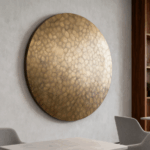Discover why stainless steel has emerged as a preferred choice for sculptors worldwide. In this article, we delve into the qualities that make stainless steel not just a material, but a legacy for artistic expression.
Stainless steel stands out for its exceptional strength and durability, making it a superior choice for sculptures. Its ability to withstand various environmental elements ensures that a stainless steel statue remains timeless, both in aesthetics and structure.
But what exactly sets stainless steel apart in the realm of sculpture materials?
What Makes Stainless Steel Unique for Statues?

Stainless steel is renowned for its corrosion resistance, material strength, and reflective surface, making it an ideal choice for both outdoor and indoor sculptures. Its durability means sculptures can stand the test of time against elements, maintaining their original glory without the need for repolishing. Duplex stainless steels, with their high strength and excellent corrosion resistance, are particularly suited for durable structures and artworks, even in aggressive coastal environments (Backhouse & Mameng, 2019).
Comparing Metals: Why Stainless Steel Over Bronze?
While bronze has been a traditional choice for sculptures, stainless steel offers a modern alternative with several advantages. Its strength and resistance to corrosion surpass that of bronze, ensuring longevity and ease of maintenance. Stainless steel’s adaptability in form and finish allows for a broader expression of creativity. Advances in materials processing have led to the development of duplex stainless steels with superior mechanical properties, broadening the possibilities for construction and artistic applications (Baddoo, 2008).

The Artistic Versatility of Stainless Steel

The ability of stainless steel to be molded into various forms and its compatibility with different surface finishes enable artists to explore new dimensions of creativity. Whether it’s creating reflective surfaces or intricate textures, stainless steel supports a wide range of artistic visions. The development of lean duplex stainless steel, with its high strength and low cost, offers an attractive option for load-bearing applications in construction, including artistic structures (Theofanous & Gardner, 2010).
Stainless Steel Sculptures in the Outdoor Environment
Outdoor sculptures face the challenge of weathering and environmental damage. Stainless steel’s inherent resistance to rust and corrosion makes it an exemplary material for outdoor art, ensuring that sculptures remain as intended for generations. Its recyclability and alignment with environmental conservation efforts also make stainless steel a sustainable choice for sculptures, emphasizing the role of art in promoting a healthier planet (Rossi, 2014).

Sustainable Art: The Environmental Benefits of Stainless Steel

Emphasizing sustainability, stainless steel is recyclable, aligning with environmental conservation efforts. Artists and collectors who prioritize eco-friendliness can find solace in choosing stainless steel for their sculptures, contributing to a healthier planet. The durability and wear resistance of laser-textured hardened stainless steel surfaces with hydrophobic properties further demonstrate the material’s suitability for lasting artistic and practical applications (Garcia-Giron et al., 2019).
In the world of sculpture, choosing the right material is paramount. Stainless steel not only offers unmatched durability and resistance but also opens a canvas for artistic innovation. Embrace the future of sculpture with stainless steel, where your artistic vision meets timeless elegance.









